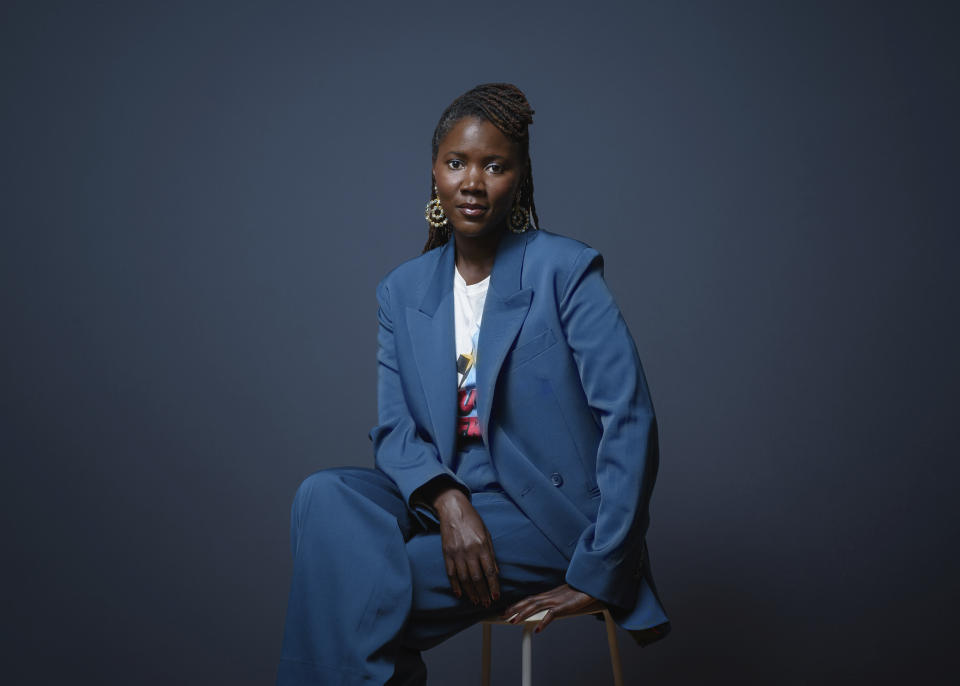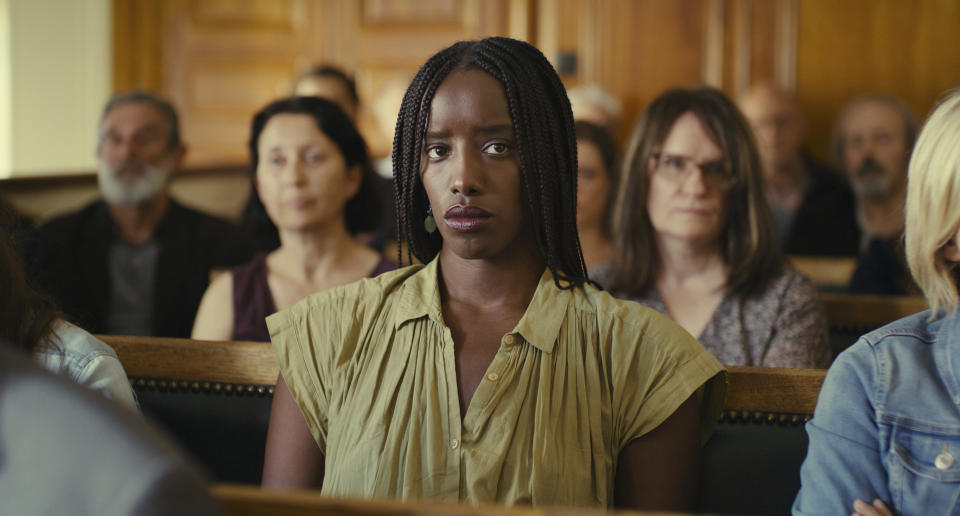Q&A: Filmmaker Alice Diop mines darkness in 'Saint Omer'
- Oops!Something went wrong.Please try again later.
In 2016, French documentary filmmaker Alice Diop made an unusual decision. She decided to travel to a town in Northern France to watch the trial of a Senegalese woman, Fabienne Kabou, who one night in 2013 left her 15-month-old daughter on the beach to die.
Diop didn’t tell anyone she was going. She wasn’t even quite sure herself. But what she witnessed over the course of those few days would inspire her first narrative film, “ Saint Omer,” which opens in U.S. theaters Friday.
Quiet and haunting, “Saint Omer” is not your standard courtroom drama, nor is it a garish “true crime” spectacle. In it, a pregnant novelist, Rama (Kayije Kagame), bears witness to the testimony of Kabou stand-in Laurence Coly (Guslagie Malanda). Since winning the feature debut award at the Venice Film Festival, “Saint Omer” has continued to collect accolades and nominations, including a spot on the Oscars shortlist.
With an English translator by her side, Diop spoke to The Associated Press this week about her intentions for the film, the “invisible women” at its heart and the unexpected catharsis she found that she wanted to also give to audiences. Remarks have been edited for clarity and brevity.
AP: Why do you think you were compelled to go to the trial?
DIOP: I went to the trial because I had a very strong intuition. But for a very long time, I didn’t know what it was about. I didn’t think, ‘Oh, I’m going to go to the trial and make a film about it.’ I think as a woman, as actually many other women around me, I was completely fascinated by this story. I really went as a woman. What struck me was a sentence that the defendant said to the police. When the inspector asked, ‘Why did you kill your daughter?’ she said, ‘I laid my daughter on the sand because I wanted the sea to take her away.’ For the French, it carries a very profound, psychoanalytic dimension because in French, the mother and the sea are the same word (mère and mer). In my head, I had the fantasy that she offered her daughter to a mother that was more powerful than she felt. It is this imagery of this mythological concept that became a magnet for me. But during the five days that I listened to this trial, I had no idea that it was going to draw me to the deepest, darkest place of my being.
AP: Having a child myself viscerally changed how I processed movies and stories about children in distress. Did you have an experience like that too, as a mother thinking about a story like this?
DIOP: I can’t exactly say that. But it is true that my partner was very concerned by my obsession with this story. Even for me it was a complete mystery. I did not understand why me, as a Black woman, could be so fascinated by this story of a Black woman that had killed her child. That was incomprehensible to me. I’m going to tell you something very personal, which I never talk about. I actually had a very deep postpartum depression when my child was a baby. And I believe that this trial is what helped me heal out of that depression. I not only forgave myself, but I also forgave my mother. It’s as if this trial was helping me, killing all this trauma.
AP: Thank you for sharing that, I feel like I may cry. We can certainly shift to talking more about the film.
DIOP: It’s less dangerous if we talk about the film.
AP: The idea of the invisible woman comes up often. Can you talk about the significance of that?
DIOP: I think it’s a very central point of the film. It frames and puts light on the woman that nobody listened to, that nobody saw, that nobody was aware of. And the mother of this woman, the mother of the character Rama, as my mother and all the mothers of this generation of immigrant women, are women that the cinema never showed or talked about. This is what determined one of the most important concepts of this film, which is those very long one takes so that the audience would finally have the opportunity to intensely observe and listen to these women for the first time. For me that is a political statement, and it is also what drove me to want to make cinema. It’s a tool to show these women, to put those woman in the center of visibility when nobody else did it, and to understand the complexity of the character rather than the cliché.
AP: The score is also sparse but impactful.
DIOP: I wanted this score, the music, to evoke the theatricality and the myth of emotion that I wanted to bring to the film, like a Greek chorus, a group of women together wanting to observe and watch this strange phenomenon that took place. And as far as the last piece, the Nina Simone song (“Little Girl Blue”) to me is the voice that comes and brings consolation and soothing to everything that we just witnessed.
AP: It is surprising to be able to find catharsis in such a horrifying case.
DIOP: The film works very hard in withholding the emotion, in keeping it inside. There is a liberation of that emotion when we have the lawyer’s closing argument toward the end. Finally, when Nina’s song comes, nobody can hold the emotion anymore and what people feel is no longer the story of the film, but their own story, as women, as little girls. This film, the way I wrote it, was to give the audience the specter of personal experience as if they had followed the trial themselves. I was in tears at the end of the trial, and I know lots of women who watch it are completely overwhelmed with emotions.
___
Follow AP Film Writer Lindsey Bahr on Twitter: www.twitter.com/ldbahr.







